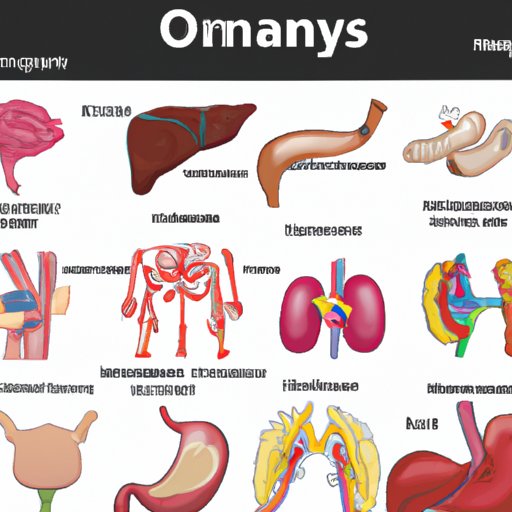Introduction
An organ is a group of tissues that work together to perform a specific function in the human body. Organs form the basis of the different systems in the body, such as the digestive system, respiratory system, and circulatory system, and are essential for life. In order to understand how organs work, it is important to look at their anatomy and physiology.

Exploring How Different Organs Work Together
Organs in the body work together to maintain homeostasis, or balance, in the body. Each organ has its own unique function that contributes to the overall functioning of the body. For example, the lungs take in oxygen from the air and deliver it to the bloodstream, while the heart pumps the oxygenated blood throughout the body. The kidneys filter waste from the blood and excrete it from the body, while the liver works to metabolize drugs and other toxins.
The organs also interact with each other through hormones and chemical signals. Hormones are released by different glands in the body and travel through the bloodstream, where they can interact with other organs. For example, the thyroid gland releases hormones that regulate metabolism, while the pituitary gland releases hormones that control growth and development. Chemical signals can also be sent between organs, such as neurotransmitters that are released by the brain and travel to muscles to cause movement.
Examining the Internal Structures of Organs
To understand how organs work, it is important to examine their internal structures. Organs are composed of different types of tissues, such as muscle, nerve, and epithelial, which all have their own unique functions. For example, muscle tissue is responsible for movement, nerve tissue sends electrical signals throughout the body, and epithelial tissue lines the surfaces of organs and helps to protect them from infection.
Each organ also contains different types of cells that are specialized to perform certain functions. For example, the heart contains muscle cells that contract to pump blood, while the lungs contain alveoli that absorb oxygen from the air. Different organs also contain different types of vessels, such as arteries, veins, and capillaries, which help to transport blood and other fluids throughout the body.

Understanding How Diseases Affect Organs
Diseases can have a major impact on the functioning of organs. Common diseases that affect organs include cardiovascular disease, diabetes, and cancer. Cardiovascular disease occurs when the arteries become blocked or narrowed, which can lead to a decrease in blood flow and can cause damage to the heart and other organs. Diabetes occurs when the body does not produce enough insulin, which can lead to high blood sugar levels and can damage the kidneys, eyes, and other organs. Cancer occurs when abnormal cells grow out of control, which can damage organs such as the lungs, liver, and kidneys.
Diseases can affect organs in different ways, depending on the type of disease. For example, cardiovascular disease can cause the heart to weaken, leading to a decrease in blood pressure and an increase in the risk of heart attack or stroke. Diabetes can cause the kidneys to fail, leading to an accumulation of toxins in the blood and an increased risk of kidney failure. Cancer can cause tumors to form, which can damage organs and lead to organ failure.

Comparing the Structures and Functions of Different Organs
Organs vary in structure and function from one organ to another. For example, the heart is made up of four chambers that contract and relax to pump blood throughout the body, while the lungs contain tiny air sacs that absorb oxygen from the air and deliver it to the bloodstream. The kidneys are made up of millions of tiny filters that remove waste from the blood and excrete it from the body, while the liver works to metabolize drugs and other toxins.
Organs also vary in their functions from one organ to another. For example, the heart pumps blood throughout the body, while the lungs absorb oxygen from the air. The kidneys filter waste from the blood, while the liver metabolizes drugs and other toxins. Each organ has its own unique function that contributes to the overall functioning of the body.
Conclusion
Organs are essential for life and are composed of different types of tissues and cells that work together to perform specific functions. Organs also interact with each other through hormones and chemical signals, and can be affected by different diseases. Finally, organs vary in structure and function from one organ to another. By understanding the anatomy and physiology of organs, we can better understand how they work in the human body.
In conclusion, organs are complex structures that work together to maintain balance in the body. They are composed of different types of tissues and cells, interact with each other through hormones and chemical signals, and can be impacted by various diseases. Their structures and functions vary from one organ to another, and by understanding their anatomy and physiology, we can gain a better understanding of how organs work in the human body.
(Note: Is this article not meeting your expectations? Do you have knowledge or insights to share? Unlock new opportunities and expand your reach by joining our authors team. Click Registration to join us and share your expertise with our readers.)
